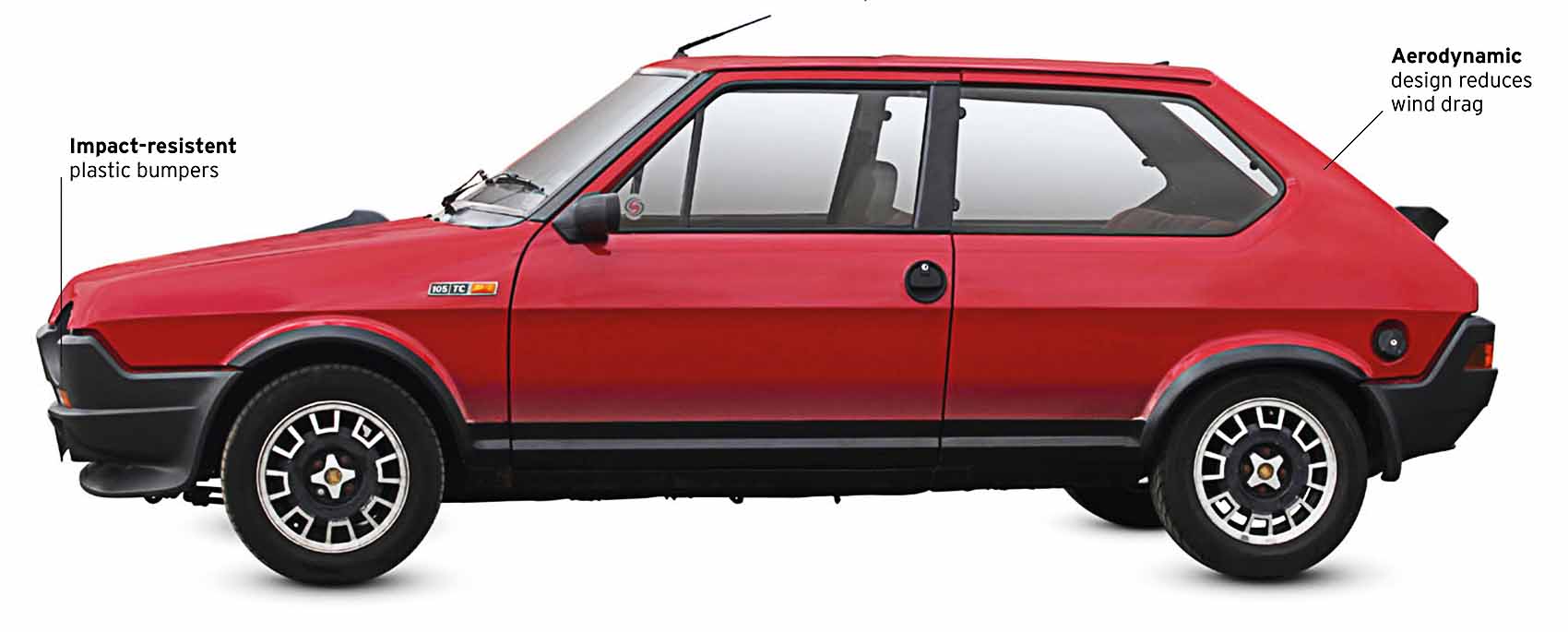
Hatchbacks
Hatchbacks were the big trend of the 1970s. Within a few years almost all small cars had adopted the front-engine, front-wheel drive layout and the semi-estate body style with three or five doors to add practicality. Fold-flat rear seats provided even more versatility. The seats were also split—one side could be folded but the other left in place for passenger use—extending the adaptability of the hatchback. Hot hatches, such as the Volkswagen Golf GTi, added performance and modern sports-car styling but retained most of the practicality. They proved immensely popular.
AMC Pacer, 1975

| Origin | USA |
| Engine | 3,802 cc, straight-six |
| Top speed | 92 mph (148 km/h) |
Advertised as “the first wide small car”, the Pacer had the passenger compartment of a sedan, the nose of a European commuter shuttle, and no back end at all. However, it did not offer the economy that drivers expected from a compact car.

Compact and quirky
Designed as a compact car for US drivers more accustomed to the interior room found in full-size models, the Pacer offered space for a driver and three passengers. It was quickly dubbed “The Flying Fishbowl”.

Fuel-saving design
American Motor’s chief stylist Richard A. Teague developed the Pacer’s aerodynamic design in response to the two fuel crises of the 1970s. The car’s slippery shape achieved a relatively low drag efficiency, but its large engine proved thirsty. Nonetheless the car sold well.
Austin Maxi, 1969

| Origin | UK |
| Engine | 1,748 cc, straight-four |
| Top speed | 97 mph (156 km/h) |
The packaging skills of Alec Issigonis shone in the transverse-engined Maxi, the last car he produced before retirement. It had hydrolastic suspension and a five-speed gearbox (rare then), but its cable operation proved unreliable. The Maxi sold well during the 1970s.
Volkswagen Golf GTI, 1975

| Origin | Germany |
| Engine | 1,588 cc, straight-four |
| Top speed | 112 mph (180 km/h) |
Developed by Volkswagen engineers as an out-of-hours side project, the Golf GTi proved to be a phenomenal sales success and set the pattern for generations of hot hatches to come. GTi versions have been a core part of Golf model ranges ever since.
Renault 14, 1976

| Origin | France |
| Engine | 1,218 cc, straight-four |
| Top speed | 89 mph (143 km/h) |
Renault sold almost a million of this pear-shaped, five-door hatch. It featured a transverse canted-over Douvrin engine with its transmission in the sump, which it shared with the Peugeot 104 and Citroen Visa. Spacious and comfortable to ride in, the car was prone to rust.
Fiat Strada/Ritmo, 1978

| Origin | Italy |
| Engine | 1,585 cc, straight-four |
| Top speed | 111 mph (179 km/h) |
Fiat was keen to stress that this car was built by robots. Its geometric lines led some to suggest it had been styled by them, too. The car had a peppy engine and tidy handling, but protection from rust was feeble. Abarth’s twin-cam performance versions were reputedly fun to drive.
It is a quote. The Classic Car Book – The Definitive Visual History 2016




